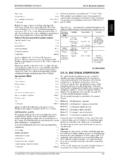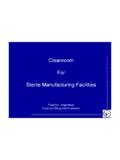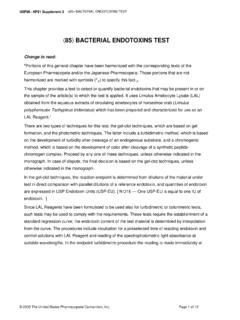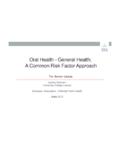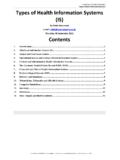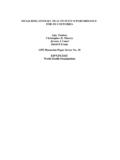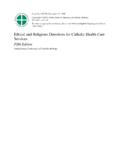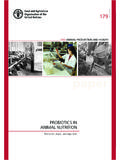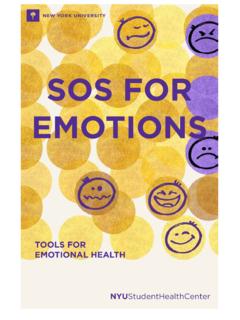Transcription of World Health Organization - gmpua.com
1 World Health Organization Supplementary Guidelines on Good Manufacturing Practices for Heating,Ventilation and Air conditioning (HVAC) Systems for Non-sterile Dosage Forms Praphon Angtrakool Working document (2004) Food and Drug Administration 1. Introduction X HVAC systems assists in ensuring the manufacture of quality products and also result in operator comfort. X HVAC systems design influences architectural layouts, with regard to items such as airlock positions, doorways and lobbies. X The prevention of the contamination and cross-contamination is an essential design consideration of the HVAC system.
2 X The design of the HVAC system should be considered at the concept design stage. 1. 2. Glossary (1). X Cleanroom : A room or area with defined environmental control of particulate and microbial contamination, constructed and used in such a way as to reduce the introduction, generation and retention of contaminants within the area, and in which other relevant parameters ( temperature, humidity and pressure) are controlled as necessary. X Containment : A process or device to contain product, dust or contamination in one zone, preventing it from escaping to another zone. 2. 2. Glossary (2). X Contamination : The undesired introduction of impurities of a chemical or microbial nature, or of foreign matter, into or on to a starting material or intermediated, during processing, sampling, packaging or repackaging, storage or transport.
3 X Cross-contamination : Contamination of starting material, intermediated product or finished product with another starting material or material during production. 3. 3. Scope X HVAC systems for oral solid dosage facilities X The three primary aspects addressed in this manual are the role that the HVAC system play in Y product protection Y personnel protection Y enviromental protection 4. Protection Aspects GMP Manufacturing Environment Product Protection Personnel Protection Environment Protection Contamination Prevent contact with dust Avoid duct discharge (Product & Staff). Protect from Product Prevent contact with fumes Avoid fume discharge (cross-contamination).
4 Correct temperature & humidity Acceptable comfort conditions Avoid effluent discharge SYSTEM. SYSTEM VALIDATION. 5. 4. Product Protection (1). Contamination control Cleanroom concept Level of protection Air filtration to control contamination Contamination by HVAC plant Contamination by staff Airflow patterns Uni-directional flow protection Infiltration 6. 4. Product Protection (2). Cross-contamination protection Directional air movement - Displacement concept - Pressure differential concept - Physical barrier concept - Selecting the segregation concept Uni-directional flow protection Cross-contamination via HVAC supply air Cross-contamination due to fan failure 7.
5 4. Product Protection (3). Temperature and Humidity General requirements Product temperature requirements Product humidity requirements Microbial growth 8. 5. Personnel Protection Protection from dust Dust classification Uni-directional flow protection Point extraction Directional airflow Air shower Protection enclosures Operator comfort 9. 6. Protection of the Environment Extraction air dust Fume removal Effluent discharge 10. 7. System and components Air distribution Air handling unit configurations Re-circulation system Full fresh air systems Additional system components 11. 4. Product Protection (1).
6 Contamination control X Through all stages of processing, product should be protected from contamination and cross-contamination. X These include contamination resulting from Y inappropriate building finishes Y plant layout Y poor cleaning procedures Y lack of staff discipline Y poor HVAC system 12. Cleanroom concept X Pharmaceutical manufacturing facilities where pharmaceutical products, utensils and manufacturing equipment are exposed to the environment, should be classified as cleanrooms . X The shell-like containment control concept : The process core is regarded as the most stringently controlled clean zone which is protected by being surrounded by cleanrooms of a lower classification.
7 X Internal contaminants should be removed by dilution and flushing of contaminants in the room, or by displacement airflow. 13. Shell-like containment control concept OUTDOOR ENVIRONMENT. PERSONNEL MOVEMENT. PERSONNEL MOVEMENT. ANCILLARY AREAS. CLEANROOMS. MATERIAL TRANSPORT PROCESS CORE FINAL PRODUCT TRANSPORT. CLEAN ZONES. WASTE. 14. Cleanroom condition X as built : condition where the installation is complete with all services connected and functioning but with no production equipment, materials, or personnel present X at rest : condition where the installation is complete with equipment installed and operation in a manner agree upon by the customer and supplier, but with no personnel present X operational : condition where the installation is functioning in the specified manner, with the specified number of personnel and working in the manner agreed upon 915.
8 Cleanroom condition as built at rest in operation air air air 16. Cleanroom concept (cont.). Many multinational pharmaceutical manufacturers have their own minimum air change rate standards for oral dosage facilities, and these typically vary between 6 and 20 air changes per hour. Generally a room that is tested for an operational condition, should be able to clean up to a higher at rest cleanroom classification, after a short clean-up condition. The clean-up time should normally be in the order of 20 minutes. 17. Level of Protection (1). X Level 1 (General) : An area with normal housekeeping and maintenance.
9 ( Warehousing, Secondary Packing). X Level 2 (Protected) : An area in which steps are taken to protect the exposed drug substance from contamination or degradation. ( Manufacturing, Primary Packing, Dispensing, etc.). X Level 3 (Controlled) : An area in which specific environmental conditions are defined, controlled and monitored to prevent contamination or degradation of the drug substance. 18. Level of Protection Typical Zone Typical Dress Code GMP Guides ISO Class Equivalent Street, canteen External External Outdoor clothes Receipt & dispatch Level 1 or Unclassified ISO Class 9 Appropriate to area Warehousing.
10 Offices Level 1 or Unclassified ISO Class 9 Appropriate to area Weighing & dispensing Level 2 background ISO Class 8 background Clean garments Level 3 open product ISO 6 or 7 open product Blending Level 2 or 3 ISO Class 8 or 7 Clean garments Granulation Level 2 or 3 ISO Class 8 or 7 Clean garments Milling Level 3 ISO Class 8 or 7 Clean garments Encapsulation & Level 2 ISO Class 8 Clean garments compression Coating Level 2 ISO Class 8 Clean garments Primary packing Level 2 or 3 ISO Class 8 or 7 Clean garments Secondary packing Level 1 or Pharmaceutical ISO Class 9 Captive coat, hat and overshoes Non-sterile processing Controlled or Class 100000 ISO Class 8 Clean garments (in operation).




